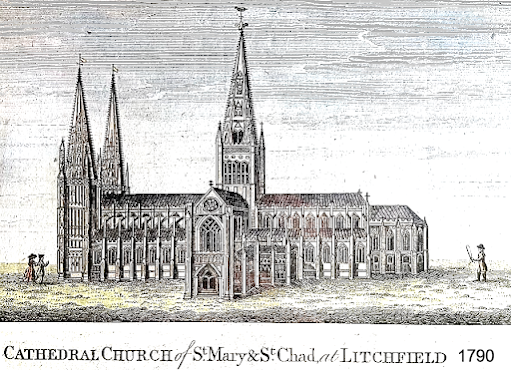Summary. The
current, third cathedral is comparatively small. It was once a cute king’s,
secure cathedral. With Bishop Langton it became a small, secure, bishop’s
cathedral next to his palace. In the Civil War it was an impregnable,
fortified, compact target to besiege. Its small size is a defining feature.
If the current cathedral was built on or around a previous Norman cathedral it would be expected to have a solid, bulky and buttressed layout. It would also be large with extensive grounds. It would present as formidable and powerful. In fact, it is almost the smallest of the medieval cathedrals. Seven of the 26 Norman cathedrals exceed 150 m in length and 8 exceed 120 m, whereas Lichfield is a mere 113 m long.
|
|
Length in metres |
Length in feet |
|
Glastonbury Abbey ruins |
177 |
580 |
|
Bury St Edmunds |
174 |
570 |
|
Winchester |
169 |
554 |
|
St Albans Abbey |
168 |
550 |
|
Canterbury |
167 |
547 |
|
Ely |
164 |
537 |
|
Wells |
127 |
415 |
|
|
Approx. start of
build |
Approx. area (m2) |
Crypt |
|
York Minster |
1220 |
12,160 |
ü |
|
St Pauls |
1087/1256/1697 |
7833 |
ü |
|
Lincoln |
1072/1185 |
6215 |
ü |
|
Chichester |
1075/1199 |
6000 |
û |
|
Winchester |
1079 |
5964 |
ü |
|
Westminster Abbey |
1040s/1245/1376 |
5734 |
ü |
|
Worcester |
1084 |
5720 |
ü |
|
Gloucester |
1089 |
5720 |
ü |
|
Canterbury |
1070/1174/1834 |
5528 |
ü |
|
Ely |
1083 |
4273 |
ü |
|
Bath |
1090 |
4000 |
? |
|
St Albans |
1077 |
3645 |
û |
|
Durham |
1093 |
3575 |
ü |
|
Peterborough |
1118 |
3483 |
tunnels |
|
Norwich |
1096 |
3233 |
û |
|
Old Sarum, Salisbury |
1075/1120 |
2700 |
ü |
|
Wells |
1175 |
2700 |
û |
|
Exeter |
1133 |
2574 |
û |
|
Hereford |
1079 |
2494 |
ü |
|
Lichfield |
late 11th or 12th
century |
2,300* |
û |
The table shows a relative comparison of size. Areas are only
approximations and many are taken from Bell’s handbooks on cathedrals. Many
dates are derived. *This is the area calculated for the supposed Norman
cathedral.
Coventry Cathedral started 1115–1140. Only one third of the site has
been excavated, so there is some uncertainty. The west front was wider than
Lichfield, the nave (21 m wide) the same and overall was more than 3 times
larger. The east end was a later addition. It is uncertain whether it had
spires. This richly
endowed cathedral lost its monasitic community and then was destroyed during the 1539 Suppression.
Lichfield’s third cathedral was once a cute king’s, secure cathedral. With Bishop Langton it became a small, secure, bishop’s cathedral. In the Civil War it was an impregnable, fortified, compact target to besiege. It is now a relatively small, but well-adorned and admired cathedral. Its size, small and tall, is a distinctive feature. Savage was of the opinion the small size arose when the Close was walled and this meant the cathedral and clergy houses had to be squeezed into the area within the wall.[3]


